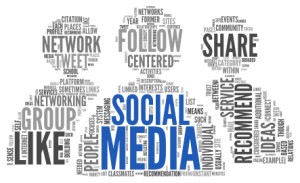by Glen Springer | May 27, 2013
 If you are trying to sell anything in 2013, it is likely you are trying to do so in the digital space. The internet and internet-based technologies have changed the B2B selling and buying process immensely, and you now need to be able to easily find and engage with your customers online.
If you are trying to sell anything in 2013, it is likely you are trying to do so in the digital space. The internet and internet-based technologies have changed the B2B selling and buying process immensely, and you now need to be able to easily find and engage with your customers online.
Evidence of this dramatic shift towards digital is everywhere. Let’s take Nike for example. In the past three years, Nike has dropped their print and TV ad spend by 40% and has instead invested $800 million in nontraditional advertising (method10x10.com). Additionally, Econsultancy’s 2013 marketing survey found that 39% of marketers plan to increase spend on digital marketing without increasing the marketing budget overall.
But the most interesting statistic regarding this shift comes from Gartner, who has predicted that by 2017, CMOs will spend more on technology than CTOs.
What this shows is that as we go forward, technology and marketing’s relationship will only become more intertwined. A marketer’s job is no longer purely about branding and positioning. A marketer must now understand how to integrate a brand story with digital marketing platforms and measure the results of his/her efforts.
To do that, marketers need technology.
With the right technologies, marketers can aggregate and analyze huge amounts of data in order to understand their customers, deliver the right messages in the right platforms at the right times, and measure their success. In other words, technology eliminates the guesswork and subjective opinions that have classically defined marketing and replaces them with statistical data and a clear ROI.
Overall, CMOs are spending more than CTOs on technology because of the value it brings to their companies and themselves.
Marketing automation, social media marketing, customer relationship management and customer analytics are all now permanent fixtures in the B2B sales landscape and are impossible without the right technologies. When CMOs know how to leverage these technologies to build effective digital marketing content and campaigns, they are able to reach their customers more quickly and effectively while simultaneously collecting data that shows clear ROI for their efforts.
In summary, CMOs now need to be as much of an expert in technology as they are in branding. CMOs need to be able to come up with a strategic brand story that demonstrates a company’s value and at the same time manage the company’s technology stack, deliver messaging across multiple platforms, analyze social media for trends and insights, assess the effectiveness of new marketing technologies, and show the ROI for all marketing efforts (Experian).
If you would like to know more about the changing B2B sales landscape or why CMOs are spending more than CTOs on technology, you can download our white paper called “New Rules for Sales & Marketing in 2013 & Beyond.” If you have any questions, please feel free to contact us.
by Glen Springer | May 22, 2013
 When Apple announced that it would be releasing its first phone in January of 2007, the media and tech world lit up with excitement about the new device that was promised would “work like magic.”
When Apple announced that it would be releasing its first phone in January of 2007, the media and tech world lit up with excitement about the new device that was promised would “work like magic.”
Bloggers, pundits and tech geeks created an online buzz that quickly escalated from giddy excitement to fanatical worship. If you think I’m exaggerating, here are a few examples:
“. . . tech bloggers described the ‘Jesus phone’ as ‘the holy grail of all gadgets’ (Danneskjold, 2007) and questioned how other cellphone companies might develop strategies for ‘dealing with the Second Coming”
“An Asian blogger used an image of the ‘sacred heart of Jesus’, but added an iPhone in his left hand held next to his heart.”
“PVP comics online even published a strip featuring ‘Jade’ trying to comfort her Apple-fanatic boyfriend ‘Brent’ who became catatonic after seeing Apple’s iPhone announcement, finally explaining his shock as ‘Jesus has come back and now he’s a phone’.”
~excerpts from Campbell and La Pastina, How the iPhone Became Divine, 2010
Most marketers and advertisers would kill for this kind of hype around the launch of a new product. When people are calling your product the Second Coming on their own, there’s not much work to do, right?
Wrong.
While the exact numbers are not available, it is estimated Apple spent around $250 million with their marketers and advertisers in the year leading up to the iPhone’s release. It is also estimated Apple spent another $20 million launching the iPhone in Europe.
So, what can we learn from Apple now that the iPhone has become the most successful cellular device in history? Even if you’re selling a handheld Jesus, you need to spend a lot of time and resources on launch.
Apple has been praised for being on the leading edge of marketing and advertising since their famous “1984” advertisement during the Super Bowl of the same year. But what Apple did well with the launch of the iPhone was knowing when to initiate the hype and when to let it happen on its own.
After announcing the release of one of the most anticipated products in history, Apple stood back and let the media build up the hype to a religious fever. When the public conversation waned in the mass media and blogosphere, Apple would release a brilliantly executed TV advertisement or print ad campaign. By the time the iPhone was finally released six months later, Apple’s target audience was in a state of pure devotion and desire.
So, the second thing we can learn from Apple is that even the people who invented the most revolutionizing product of the century needed help getting it to market. Apple spent millions to hire advertising and marketing experts who could provide insights and come up with ideas as to how to sell to the masses.
By spending the money to hire experts who understood Apple’s target audience and how to sell effectively in today’s digital world, Apple had possibly the most successful product launch in history. What could hiring sales and marketing experts do for your new product?
If you have any questions or would like to speak to a representative about a B2B sales and marketing outsourcing solution, please feel free to contact us.
by gabriel_sales | May 16, 2013
 When you think about your personal internet use, it is likely you spend a significant portion of your time watching videos of some kind. People using the internet today are accustomed to being able to consume information through video format, which can be seen by the fact that YouTube now has roughly 4 billion views per day. If your B2B company can present its sales and marketing messages through this platform, you will be ahead of your competitors.
When you think about your personal internet use, it is likely you spend a significant portion of your time watching videos of some kind. People using the internet today are accustomed to being able to consume information through video format, which can be seen by the fact that YouTube now has roughly 4 billion views per day. If your B2B company can present its sales and marketing messages through this platform, you will be ahead of your competitors.
You should start by setting up and YouTube channel for your company, which you can think of as your own television station. Through this station, you can present educational videos on industry trends, demonstrations of how your product or service solves business problems, testimonials from your past clients, short ads about promotional offers, etc.
The key to using video as a marketing strategy is to not to push the sale too hard. Just like on television, deliberately pushy ads can annoy. What you should focus on instead is providing something of value to your viewers. If you can give them something entertaining, or better yet useful, your video will be much more likely to deliver the sales results you desire. Using videos in your B2B digital marketing strategy can help you achieve your sales goals by improving retention (because you can show customers how to use your product/service) and fueling the decision-making process during the customer acquisition phase of the sales cycle.
Because producing and posting online videos is generally cost-effective, this is one area of digital marketing where you stand to gain a lot from a little effort. In the B2B sales world where time equals money, it really does not get much better than that.
For more information on using video marketing for B2B sales, please reach out to us at Gabriel Sales. You can find our contact information here.
by gabriel_sales | May 10, 2013
 It’s 2013, and it is safe to say that if your B2B company is not using social media as a marketing tool, you are behind. This is because many B2B companies (including your competitors) have realized the tremendous value in leveraging social media sites into their overall sales strategy. If for some reason your business has yet to join the social media world, this blog is meant to help introduce you to B2B social media marketing.
It’s 2013, and it is safe to say that if your B2B company is not using social media as a marketing tool, you are behind. This is because many B2B companies (including your competitors) have realized the tremendous value in leveraging social media sites into their overall sales strategy. If for some reason your business has yet to join the social media world, this blog is meant to help introduce you to B2B social media marketing.
In general, social media are websites and applications that allow users to create profiles, publish information and connect with friends and businesses. The users of these sites connect by ‘adding’ or ‘following’ one another. By adding or following someone or some company, you in effect ‘subscribe’ to all of the content they publish. The type of content published varies across the different social media platforms.
The largest and most predominant social media site today is Facebook. Facebook currently has 1.06 billion users and is mainly used by individuals to carry out digital, interpersonal relationships. However, businesses of all kinds have started to use Facebook as a way to help market their company, build their brand and connect with their customers in the digital space. Many B2B companies have recently discovered that most of their current customers and potential prospects are already on Facebook and have started to create Facebook-based marketing strategies to expand their reach. Using Facebook, B2B marketers can now push updates on new products, promotions or other activities to a large number of interested people, with a single click.
Twitter is another social media site B2B companies are using to build brand awareness and expand their reach. Twitter is similar to Facebook in that people ‘subscribe’ to your content by following you. Twitter differs in that the content published by users is in the structured form of a ‘tweet’. A tweet is a short message (140 characters max.) that can include short ideas, quotes, links to other pages, etc. In the B2B world, tweets are a great place to post industry trends, a problem you helped solve for one of your clients or even some simple ad copy. The one thing to remember with Twitter is your tweets should always stay on topic to things your followers are interested in.
The social media site most conducive to making B2B connections is LinkedIn. LinkedIn was designed explicitly for business professionals, meaning B2B people are already using it. This is now a place where B2B companies are making new connections with buyers and increasing their contacts.
Google+ is also becoming a major player in the social media world for B2B sales and marketing. With now two times the number of users as LinkedIn (400 million), Google+ may prove to be a major competitor to Facebook in the future. The value of this for B2B companies is that Google+ is more conducive to marketing than any of the other sites in that activity on Google+ is automated into its search engine.
If your B2B company has yet to take any action towards social media marketing, setting up profiles, finding followers and posting may seem like a daunting task. However, it helps to look at these social media sites as communities that you wish to join. Just like physical communities, once you start participating in digital communities, people starting interacting with you and relationships start to form. On the other hand, if your company simply puts up a profile and then does nothing with it, social media sites aren’t likely to produce marketing results. You need to remain constantly active on these sites, not just publishing your own content, but also interacting with the content posted by others. Used properly, these sites can easily translate into B2B lead generation and increased revenue.
For more information on leveraging social media as a marketing strategy for B2B sales, please reach out to us at Gabriel Sales. You can find our contact information here.
by gabriel_sales | May 6, 2013
 In 2013, many B2B companies are trying to improve their sales and marketing by hiring a new sales representative to join their sales team. While allocating more time and effort to the task of sales is the right thing to do, hiring a full-time rep internally might not be your best option. This blog explores how hiring an outsourced sales team can help you achieve your business goals more efficiently and effectively than an internal rep.
In 2013, many B2B companies are trying to improve their sales and marketing by hiring a new sales representative to join their sales team. While allocating more time and effort to the task of sales is the right thing to do, hiring a full-time rep internally might not be your best option. This blog explores how hiring an outsourced sales team can help you achieve your business goals more efficiently and effectively than an internal rep.
If you look at the process of hiring a new in-house salesperson, you see that it is a considerable expense to you. You have to spend time searching for the right person and training him or her once found. After all of this, you still do not come close to the amount of ability, competence and connections you have in a full team of people. In addition, you may be hesitant to let an internal person who is not working out go because of the significant investment you made beforehand. We therefore believe you stand to gain more success from hiring an outsourced team than you do with an internal rep.
Here are four more reasons we believe B2B companies can benefit from hiring an outsourced sales team:
1) Low overhead cost and zero fixed payroll or benefit costs. An outsourced sales team has its own office space, phones and computers to use, eliminating those costs for you. If you go with the outsourced team you also do not have to treat the team as your own employees in terms of payroll and benefits.
2) Access to a larger and more resourceful sales team. In most situations, the cost of an entire outsourced sales team is the same as hiring one full-time rep internally.
3) Improved sales coverage. When you have multiple people, you are able to increase the number of people you reach and expand your list of potential customers.
4) Advantage of previously established business relationships. By hiring an outsourced team, you gain access to a variety of connections and contacts you can exploit to gain profit for your company.
If you would like to know more about the pros and cons of an Internal Sales Rep vs. Outsourced Sales Team, please reach out to us at Gabriel Sales by contacting us here.
 If you are trying to sell anything in 2013, it is likely you are trying to do so in the digital space. The internet and internet-based technologies have changed the B2B selling and buying process immensely, and you now need to be able to easily find and engage with your customers online.
If you are trying to sell anything in 2013, it is likely you are trying to do so in the digital space. The internet and internet-based technologies have changed the B2B selling and buying process immensely, and you now need to be able to easily find and engage with your customers online.
 When Apple announced that it would be releasing its first phone in January of 2007, the media and tech world lit up with excitement about the new device that was promised would “work like magic.”
When Apple announced that it would be releasing its first phone in January of 2007, the media and tech world lit up with excitement about the new device that was promised would “work like magic.” It’s 2013, and it is safe to say that if your B2B company is not using social media as a marketing tool, you are behind. This is because many B2B companies (including your competitors) have realized the tremendous value in leveraging social media sites into their overall sales strategy. If for some reason your business has yet to join the social media world, this blog is meant to help introduce you to B2B social media marketing.
It’s 2013, and it is safe to say that if your B2B company is not using social media as a marketing tool, you are behind. This is because many B2B companies (including your competitors) have realized the tremendous value in leveraging social media sites into their overall sales strategy. If for some reason your business has yet to join the social media world, this blog is meant to help introduce you to B2B social media marketing. In 2013, many B2B companies are trying to improve their sales and marketing by hiring a new sales representative to join their sales team. While allocating more time and effort to the task of sales is the right thing to do, hiring a full-time rep internally might not be your best option. This blog explores how hiring an outsourced sales team can help you achieve your business goals more efficiently and effectively than an internal rep.
In 2013, many B2B companies are trying to improve their sales and marketing by hiring a new sales representative to join their sales team. While allocating more time and effort to the task of sales is the right thing to do, hiring a full-time rep internally might not be your best option. This blog explores how hiring an outsourced sales team can help you achieve your business goals more efficiently and effectively than an internal rep.